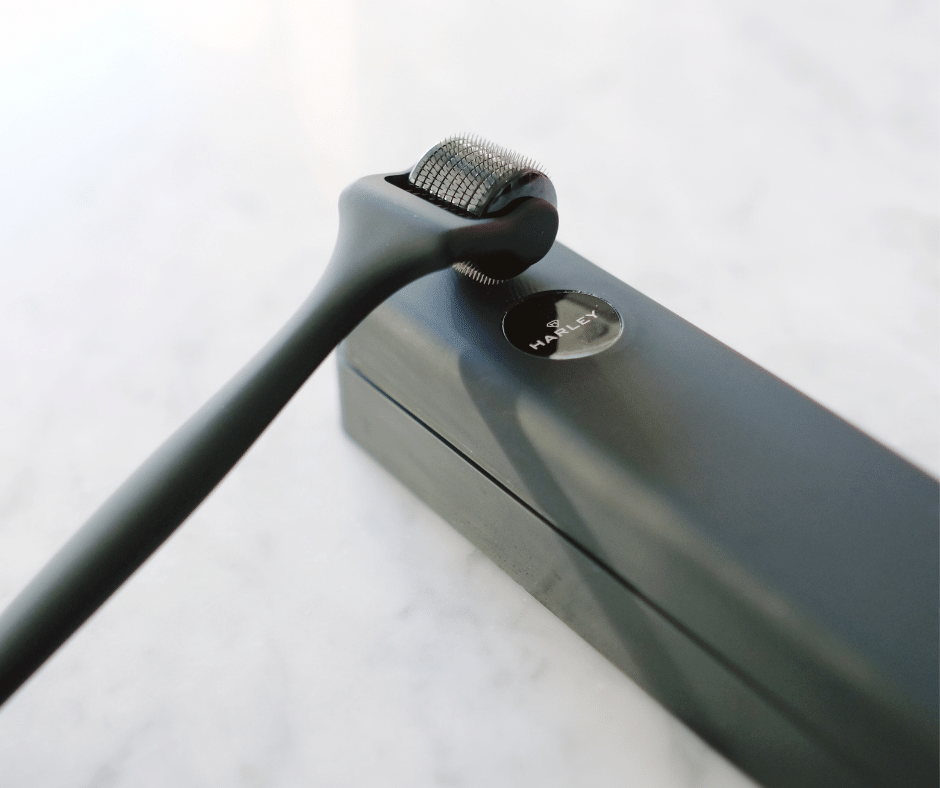
When searching for an effective treatment for male pattern hair loss, it’s easy to get caught going down a rabbit hole. Seemingly endless shampoos, vitamins, herbs, and other potions promise the world with very little or no clinical evidence to support their use.
You may have come across micro-needling a.k.a dermarolling, in your journey. While not the “silver bullet” to fix your hair loss, it may provide an additional boost to other prescribed treatments.
Let’s look at the evidence and see if introducing a dermaroller into your routine is worth the time and money.
What is micro-needling with a dermaroller, and how can it work for hair loss?
Micro-needling with a dermaroller is a treatment that has been around for many years, originally used on the skin to treat scars (especially acne scars), stretch marks, wrinkles, and facial rejuvenation.
Dermarolling involves using tiny needles on a roller to pierce the top layer of the skin to create micro-holes.
The microholes aren’t big enough to cause actual injury but instead lead to the release of growth factors that stimulate new collagen and elastin in the skin and form new capillaries.
The dermaroller is used on the scalp to treat male pattern hair loss by stimulating stem cells in the dermal papilla and activating growth factors that stimulate the hair follicle and initiate growth.
What is the evidence to support micro-needling for hair loss?
Several studies have tested the effectiveness of micro-needling on male pattern hair loss (androgenetic alopecia).
A study conducted in 2013 was the first study of micro-needling. It was a 12-week study of 100 men; group one was offered weekly micro-needling treatment with twice daily 5% minoxidil lotion (micro-needling group). In contrast, the other group was given only 5% minoxidil lotion.
The study concluded that a dermaroller along with Minoxidil was statistically superior to using Minoxidil alone in promoting hair growth in men with male pattern hair loss.
A small study in 2015 (4 men) showed an accelerated response with micro-needling, leading to a significant increase in scalp density. This study highlighted the benefits of adding micro-needling to patients that were poor responders to conventional therapies.
A more extensive study was conducted in 2018 (68 men) to determine the effectiveness of topical minoxidil plus micro-needling versus topical minoxidil alone in the treatment of androgenetic alopecia.
The study showed that the combination of micro-needling and topical minoxidil treatment was superior to topical minoxidil alone concerning an increase in the hair count and patient satisfaction. However, the response achieved was not cosmetically significant.
How is dermarolling performed?
Traditionally, dermarolling for male pattern hair loss is done in a doctors clinic after applying a topical anaesthetic. The dermaroller used typically has 1.5-2mm needles.
Using a dermaroller at home has increased in popularity in recent years; however, there are a couple of points to note before you start doing it yourself.
- Ensure your dermaroller is medical-grade.
- Get the correct needle size. Dermarollers have different needle lengths based on their use. For male pattern hair loss, the needle length should be 1.5mm.
The dermaroller is used where you’d like to target hair thinning or instill hair growth. (e.g., hairline or the side of the temples). The device is rolled back and forth over the area 3-4 times, first horizontally, then vertically, and then diagonally. You should apply enough pressure to penetrate the scalp and feel a slight prickling or tingling, but not enough to cause pain. Temporary redness may occur.
For best results, repeat weekly and only when the skin is completely healed.
As the dermaroller essentially breaks the skin barrier, you must disinfect the dermaroller with medical-grade alcohol between uses.
Conclusion
Clinical studies suggest the use of a dermaroller, in addition to conventional therapies, may offer added benefits in terms of stimulating the hair follicle and generating regrowth.
One thing to bear in mind is that the studies conducted were in a clinical setting where trained practitioners performed the micro-needling.
At-home use of a dermaroller may provide similar benefits if the needle is 1.5mm in length, and the correct amount of pressure is applied to penetrate the skin to the required depth.
A dermaroller may provide an additional way to complement an existing prescription treatment for male pattern hair loss when used correctly.
GOT Questions? Schedule a call with a qualified practitioner or send us an email at [email protected]

